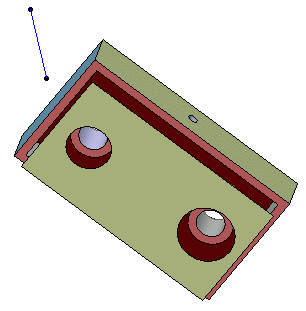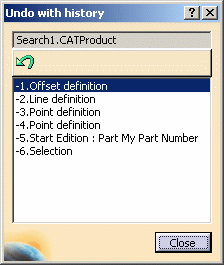 |
-
Open at least one object and perform actions that can be
reversed.
| In this scenario, the object looks like this: |
 |
-
Click
Undo
 in the Standard toolbar or select Edit > Undo xxx
(or press CTRL+Z), "xxx" corresponding to the name of the
last action performed.
in the Standard toolbar or select Edit > Undo xxx
(or press CTRL+Z), "xxx" corresponding to the name of the
last action performed.
-
If you want to reverse one or more actions preceding the
last one you simply have to repeat step 1.
| Sometimes no action can be undone. When this is
the case, the command is grayed out. By default, a maximum of
10 global undo actions is possible. This maximum can be changed
in
Tools > Options > General > PCS. |
-
If you want to
display an history of actions that can be reversed in the active
document, click Undo with history
 : :
 |
| The name of the document
in which you are about to reverse actions is displayed at the top of
the dialog box (where you can see "Search1.CATProduct"). The
Undo with history dialog box lets you choose the actions
you wish to reverse from the numbered list displayed in the bottom
part, the most recently performed action being displayed at the top of the
list.
Each action is identified by its name, for instance
"Properties Edition" refers to Edit > Properties. |
When you run a command
or or when you start editing an object, you start a global
action. Such action is identified in the Undo with history
dialog box by a name beginning with "Start" (e.g. "Start line
definition...", "Start Edition : Part xxx, etc.).
Inside a command, you perform internal transitions and some of
them are displayed in the Undo with history dialog box
with a name ending with "..." to distinguish them from global
commands (e.g. "Select search results...").
Once a command is over, local actions are committed and replaced
in the Undo with history dialog box by a global action
representing everything you did while running the command.
Note that a global action can sometimes be seen as a local action
from a more global point of view: this is the case, for instance,
for an exclusive command performed while editing, or for a shared
command used while running another command.You can reverse then
recovero internal transitions as long as you are in the command. If
several Undo actions are performed successively until the
command's starting action is reversed, the command itself is
reversed.
For instance, suppose the following scenario with two
different cases:
- step 1: copy an object
- step 2: paste the object
- step 3: select the object then move it
Case 1
Click Undo: this moves the object back to its original
position in step 2.
Click Redo: this moves the object to the location
defined in step 3.
You can reverse then recover the move since you are still in the
Select command.
Case 2
Click Undo: this moves the object back to its original
position in step 2.
Click Undo once again: the paste action is canceled
and you go back to step 1.
Click Redo: the object is pasted.
But you cannot recover step 3 after this and if you display the
history, you can see that it is empty. You cannot recover the move
because the second reversal impacts the Paste command and
not the Select command anymore. |
 |
If you want to reverse the first
action only, simply click Undo
 because the first
action is already highlighted in the list: the action is reversed
and removed from the history.If you want to reverse the first four actions, all you
need to do is click the last action to be reversed (i.e. the
fourth one in our example): clicking an action implies that all
former actions are selected as well and thus, reversed in order to
keep the history.
because the first
action is already highlighted in the list: the action is reversed
and removed from the history.If you want to reverse the first four actions, all you
need to do is click the last action to be reversed (i.e. the
fourth one in our example): clicking an action implies that all
former actions are selected as well and thus, reversed in order to
keep the history.
If you change your mind and decide to reverse the first two actions
instead, click the second action in the list: only the first two
actions are selected and not the first four anymore. |
| Bear in
mind that one history is used per document ; the history of
actions is not forwarded from one document to another. As a
consequence, reversing actions in a document opened several times
simultaneously (e.g. when opening a CATPart and a CATProduct
containing this CATPart) may corrupt data. It is recommended not
to reverse actions in a document that has been modified in another
window. |
-
When satisfied with your selection, click Undo
 to
reverse all the selected
actions.The dialog box stays open and you can keep on reversing actions. to
reverse all the selected
actions.The dialog box stays open and you can keep on reversing actions.
| In this scenario, "Line definition" has been selected which means that the line and offset creation has been reversed.
The result now looks like this: |
 |
-
To close the Undo with history dialog box,
click Close.
|
| |
More about the Undo capability
- The Select command is specific: as this is the default
command in many cases, no starting action is stored in the Undo stack
and therefore, this command cannot be stopped unless you run another
exclusive command. However, like other commands, every local action
(including shared commands) performed while running the Select
command is committed when another exclusive command is run
- Clicking Cancel in a
dialog box should trigger the undo mechanism, i.e. any action you may have
performed between the command creation and the click on Cancel
is reversed
- Clicking Undo
 cancels the last action only (i.e. the last single click) and
therefore, if a command has been run by double-clicking, it cannot be
reversed via Undo
cancels the last action only (i.e. the last single click) and
therefore, if a command has been run by double-clicking, it cannot be
reversed via Undo
- You can undo the UI-Activation of an object, however this also
cancels any other action performed during the object activation
- UI-Activation (User-Interface Activation) means that you edit or
double-click an object in order to make it UI-Active (User-Interface
Active). The UI-Active object appears in blue color in the
specification tree
- Clicking Undo
 does not enable you to restore the default settings (after changing
them via Tools > Options). This can only be done using
Reset
does not enable you to restore the default settings (after changing
them via Tools > Options). This can only be done using
Reset
 displayed at
the bottom of the Options dialog box. For more
information, refer to
Resetting Default Settings Without Locks. displayed at
the bottom of the Options dialog box. For more
information, refer to
Resetting Default Settings Without Locks.
|